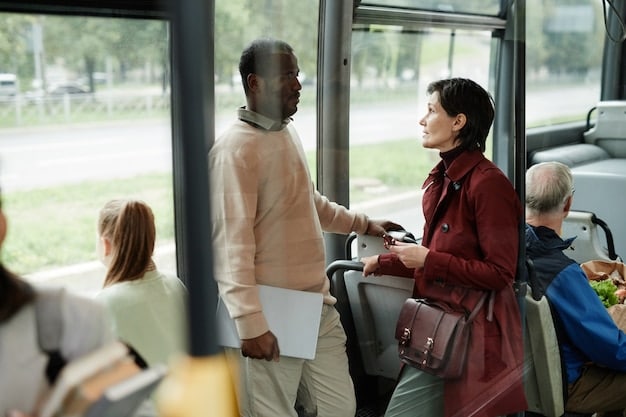Advocate for Better Public Transit: See Results in 12 Months

Improved public transportation enhances community accessibility and sustainability. To advocate effectively within 12 months, it’s critical to understand local needs, build coalitions, engage with policymakers, and use data-driven arguments, ensuring your efforts lead to tangible improvements and increased ridership.
Improving public transportation can transform your community, making it more accessible, sustainable, and equitable. But how do you turn that vision into reality? This guide outlines actionable steps to advocate for improved public transportation in your community and see results in 12 months, focusing on strategic planning, community engagement, and effective communication.
Understand Your Community’s Needs
Before launching any advocacy efforts, it’s crucial to understand the current state of public transportation in your community. This involves gathering data, listening to residents, and identifying key areas for improvement.
Assess Existing Services
Start by evaluating the current public transportation options available. Consider factors such as route coverage, frequency, operating hours, and fare structure. Analyze the strengths and weaknesses of the existing system to identify gaps and areas needing improvement.
- Review ridership data to understand which routes are most popular and which are underutilized.
- Examine service maps to identify areas where public transportation is lacking.
- Assess the accessibility of existing services for people with disabilities, seniors, and other vulnerable populations.
Engage with Residents
The most effective way to understand your community’s needs is to engage directly with residents. Conduct surveys, host town hall meetings, and create online forums to gather feedback and input. Ask residents about their experiences with public transportation, their concerns, and their ideas for improvement.

By actively soliciting feedback, you can gain valuable insights into the challenges and opportunities facing your community. This information will help you develop a targeted advocacy strategy that addresses the most pressing needs.
Understanding your community’s needs is the foundation for successful advocacy. By collecting data and engaging with residents, you can build a strong case for improving public transportation and ensuring that your efforts are aligned with the priorities of the community.
Build a Coalition of Supporters
Advocating for improved public transportation is rarely a solo endeavor. Building a strong coalition of supporters is essential for amplifying your voice and maximizing your impact.
Identify Key Stakeholders
Start by identifying individuals and organizations who share your passion for public transportation. This may include community leaders, local businesses, environmental groups, social justice organizations, and transit advocacy groups. Reach out to these stakeholders and invite them to join your coalition.
- Connect with neighborhood associations and civic groups to tap into their existing networks.
- Partner with local universities and colleges to engage students and faculty.
- Reach out to elected officials and government agencies to build support from within the system.
Create a Shared Vision
Once you’ve assembled your coalition, work together to create a shared vision for improved public transportation in your community. This vision should be specific, measurable, achievable, relevant, and time-bound (SMART). Clearly articulate your goals and objectives, and define the outcomes you hope to achieve.
By uniting diverse voices around a common cause, you can create a powerful force for change. A strong coalition will not only provide support and resources, but also increase your credibility and influence with policymakers.
Building a coalition is about bringing together different perspectives to create a unified front. By collaborating with key stakeholders, you can amplify your message and increase the likelihood of achieving your advocacy goals.
Develop a Strategic Advocacy Plan
A strategic advocacy plan is your roadmap for achieving your goals. It outlines the specific actions you will take, the resources you will need, and the timeline you will follow to improve public transportation in your community.
Set Clear Objectives
Define what you want to achieve with your advocacy efforts. Do you want to increase funding for public transportation? Expand service to underserved areas? Improve the accessibility of existing services? Clearly articulate your objectives, and make sure they are aligned with your overall vision.
Your objectives should be specific and measurable. For example, instead of saying “improve public transportation,” you might say “increase bus frequency on Route 10 by 20%.”
Outline Your Strategies and Tactics
Once you’ve set your objectives, develop a set of strategies and tactics to achieve them. Strategies are the broad approaches you will take, while tactics are the specific actions you will implement.
- Lobby elected officials to support legislation that benefits public transportation.
- Organize grassroots campaigns to raise public awareness and generate support.
- Work with local media to highlight the importance of public transportation.
- Conduct research and analysis to build a strong case for your proposals.
Establish a Timeline and Budget
Finally, establish a realistic timeline and budget for your advocacy plan. Identify key milestones and deadlines, and allocate resources accordingly. Be prepared to adapt your plan as needed, based on changing circumstances and new information.
A well-developed advocacy plan will help you stay focused, organized, and effective. By setting clear objectives, outlining your strategies and tactics, and establishing a timeline and budget, you can increase the likelihood of achieving your goals and improving public transportation in your community.

Developing a strategic plan is essential for turning your vision into action. It provides a framework for your advocacy efforts and helps you stay on track toward achieving your goals.
Engage with Policymakers and Decision-Makers
Engaging with policymakers and decision-makers is crucial for advancing your advocacy agenda. These are the individuals who have the power to make decisions about public transportation funding, policies, and services.
Identify Key Influencers
Start by identifying the key influencers in your community who have a direct impact on public transportation. This may include elected officials, transportation agency staff, planning commission members, and business leaders. Determine who supports your cause and who may be resistant, and tailor your engagement strategy accordingly.
Understanding the political landscape is essential for effective advocacy. Knowing who the key players are and what their positions are will help you target your efforts and maximize your impact.
Build Relationships
Building strong relationships with policymakers and decision-makers is essential for gaining their support. Attend public meetings, schedule one-on-one meetings, and invite them to tour public transportation facilities. Use these opportunities to educate them about the importance of public transportation and share your vision for improvement.
Remember to be respectful, professional, and persistent. Building relationships takes time and effort, but it is well worth the investment.
Present Data-Driven Arguments
When engaging with policymakers and decision-makers, it’s important to present data-driven arguments that support your proposals. Use ridership statistics, economic impact studies, and environmental assessments to demonstrate the benefits of investing in public transportation. Show how improved public transportation can reduce traffic congestion, improve air quality, and create economic opportunities.
Policymakers are more likely to support your proposals if you can provide solid evidence to back them up. By using data to make your case, you can increase your credibility and influence.
Engaging with policymakers and decision-makers is critical for advancing your advocacy agenda. By identifying key influencers, building relationships, and presenting data-driven arguments, you can gain their support and advocate for policies that benefit public transportation in your community.
Use Data and Research to Support Your Case
Data and research are powerful tools for advocating for improved public transportation. By gathering and analyzing relevant data, you can build a strong case for your proposals and demonstrate the benefits of investing in public transportation.
Collect Ridership Statistics
Gather ridership statistics for your local public transportation system. Analyze the data to identify trends, patterns, and areas for improvement. Use this information to highlight the importance of public transportation and demonstrate the need for increased funding and expanded service.
- Track ridership by route, time of day, and day of the week.
- Analyze demographic data to understand who is using public transportation.
- Compare ridership statistics to those of other communities to benchmark performance.
Conduct Economic Impact Studies
Conduct economic impact studies to assess the economic benefits of public transportation. Show how public transportation can create jobs, stimulate economic activity, and increase property values. Use this information to convince policymakers and business leaders of the importance of investing in public transportation.
Economic impact studies can demonstrate the tangible benefits of public transportation, making your case more compelling and persuasive.
Assess Environmental Impacts
Assess the environmental impacts of public transportation. Show how public transportation can reduce greenhouse gas emissions, improve air quality, and conserve energy. Use this information to appeal to environmental groups and advocate for sustainable transportation policies.
Environmental concerns are increasingly important to policymakers and the public. By highlighting the environmental benefits of public transportation, you can gain support for your advocacy efforts.
Using data and research can provide the evidence needed to convince decision-makers and the public of the importance of investing in better public transportation. Data adds credibility to your advocacy efforts and strengthens your case for improvements.
Communicate Effectively with the Public
Effective communication is essential for raising awareness, generating support, and building momentum for your advocacy efforts. By communicating clearly and persuasively, you can reach a wider audience and inspire action.
Develop a Consistent Message
Develop a clear and consistent message about the importance of public transportation. Use compelling stories, statistics, and visuals to communicate your message effectively. Tailor your message to different audiences, such as residents, policymakers, and business leaders.
Consistency is key to effective communication. By repeating your message consistently, you can reinforce your message and increase its impact.
Utilize Multiple Channels
Utilize multiple communication channels to reach a wider audience. This may include social media, websites, email newsletters, press releases, public presentations, and community events. Choose the channels that are most appropriate for your target audience and your message.
By using a variety of communication channels, you can increase your visibility and reach more people.
Engage with the Media
Engage with the media to generate positive coverage of your advocacy efforts. Write press releases, pitch stories to reporters, and participate in interviews. Use the media to highlight the importance of public transportation and share your vision for improvement.
Positive media coverage can significantly boost your advocacy efforts and increase your credibility with policymakers and the public.
Communicating your cause effectively is critical to building your support base and ensuring your voice is heard. By engaging the public through multiple channels and crafting relatable stories, the likelihood of seeing action being taken is immensely increased.
| Key Point | Brief Description |
|---|---|
| 📊 Understand Needs | Assess services and engage residents for targeted improvements. |
| 🤝 Build Coalition | Unite stakeholders with a shared vision for amplified impact. |
| 📝 Strategic Plan | Outline clear objectives, strategies, and timelines for advocacy. |
| 📣 Communicate Effectively | Develop consistent messaging and engage media. |
FAQ
▼
Begin by thoroughly understanding your community’s existing public transportation services. Assess routes, frequency, and accessibility to identify key areas needing improvement and gather insights from local residents to inform your advocacy efforts.
▼
Identify and connect with key stakeholders such as community leaders, environmental groups, local businesses, and transit advocacy groups. Collaborate to create a shared vision and define specific, measurable goals for improving public transportation.
▼
Your plan should include clear objectives, defined strategies and tactics, and a realistic timeline and budget. Outline specific actions, allocate resources, and establish key milestones to ensure your advocacy efforts are focused and organized.
▼
Engaging with policymakers and decision-makers is crucial because they have the power to influence public transportation funding, policies, and services. Build relationships, present data-driven arguments, and educate them about the importance of better transit.
▼
Collect ridership statistics, conduct economic impact studies, and assess environmental impacts to demonstrate the benefits of public transportation. Use this data to support your proposals, highlight needs, and provide concrete evidence for your advocacy efforts.
Conclusion
Advocating for improved public transportation is a challenging but rewarding endeavor. By understanding your community’s needs, building a strong coalition, developing a strategic plan, engaging with policymakers, using data to support your case, and communicating effectively with the public, you can make a real difference in your community and see tangible results within 12 months. Keep pushing, and together, we can transform our communities.





